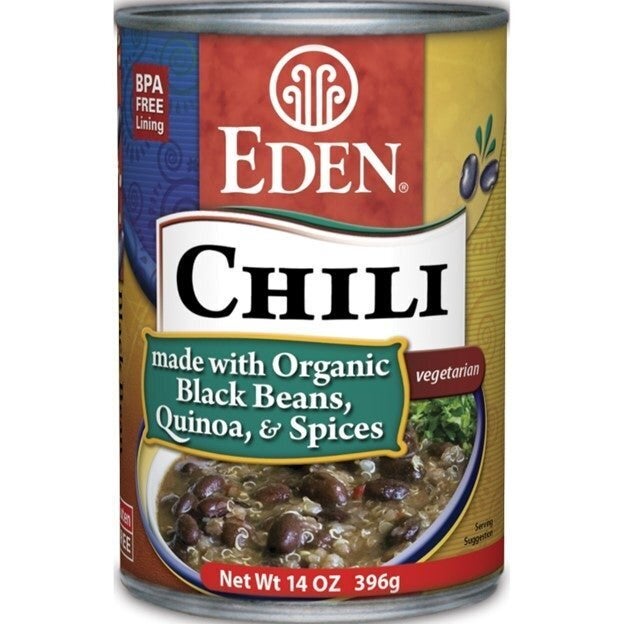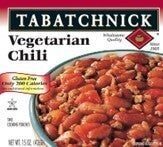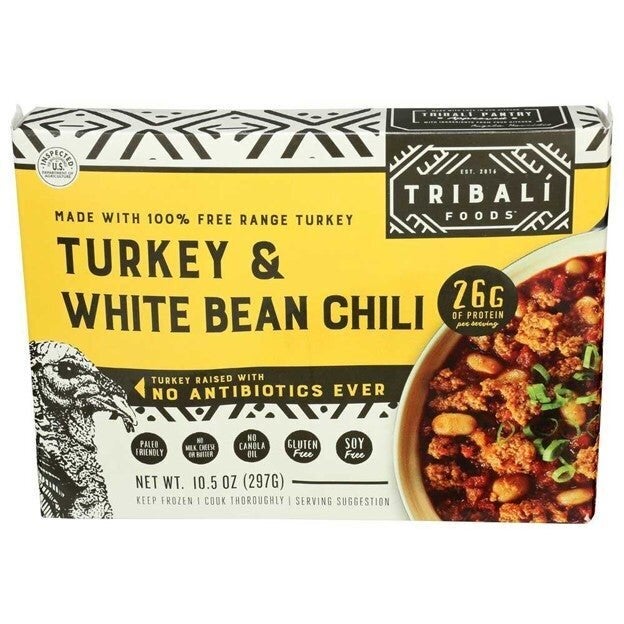When you’ve got the time, it’s fun to make your own slowly simmered, secret-ingredient chili. But sometimes you just want an uncomplicated bowl of the hearty cold-weather favorite — in a hurry. At those times, it helps to know which popular brands are actually preferred by nutritionists, and how they add other ingredients to make it a healthy, standalone meal.
“I find chili very comforting, and when you’re intentional about the ingredients, it can be nutrient-rich, too,” said registered dietitian nutritionist Kacie Barnes.
“The great thing about chili is you can use it as a foundation for your meal,” RDN Sharon Palmer said. “You can turn it into a taco salad with lettuce, tomatoes, avocados and salsa. You can serve it over whole-grain cornbread, or add it to a whole-grain wrap with veggies. You can pour it over brown rice. Plus, you can top it with green onions, cilantro and tomatoes.”
What to look for on the label
“Look for chilis that use turkey, tofu, chicken or beans,” suggested RDN Bianca Tamburello. “Those are leaner proteins that typically have less saturated fat than chili made with beef or pork.”
Sodium content can be an issue with canned food, so it’s important to check out how much is in your chili. Palmer said, “If a serving is more than 20% DV sodium, which is 460 milligrams, it’s pretty high,” she said.
Many of the nutritionists we spoke with mentioned seeking out bean-forward ingredient lists, with registered dietitian Toby Smithson insisting: “Beans should be the star of any chili.”
RDN Jerlyn Jones explained why that’s so important: “People who regularly eat beans usually have lower blood pressure and cholesterol and more stable blood glucose and insulin levels. eans can also help you maintain a healthy weight, since they’re a good source of lean protein.”
RDN Amy Gorin, an inclusive plant-based dietitian, pointed out that some packaged chili contain no beans. “I suggest opting for varieties with beans, as you’ll get a plethora of plant-based protein, fiber, vitamins and minerals,” she said.
Boost your can’s nutrition with add-ins
If you’re ready to make your bowl even more delicious, check out these personal flourishes from the nutritionists.
“This is the perfect meal for adding a big handful of spinach into the bowl,” Barnes suggested. “The leaves wilt down to almost nothing when heated and stirred in. You can top it with cubes of avocado for omega-3 fats instead of using cheese. Or use the chili as a topping for a baked potato to add extra micronutrients and fiber.”
Jones suggested adding pumpkin, carrots, celery, sweet potato or parsnips. “Whole grains such as bulgur wheat or barley provide a meaty texture to vegetarian chili and are excellent sources of fiber and B vitamins,” she said.
“If the chili doesn’t contain tomatoes, add a can or part of a can to boost nutrition,” said nutritionist Jill Nussinow. “In the summer, serve chili on top of lightly cooked summer squash. In the winter, add cubes of cooked winter squash. Chopped sweet peppers have a lot of vitamin C, so adding those seems to boost chili flavor and nutrition. And you can always add a bit of tomato paste to improve the umami flavor.”
“I usually add everything but the kitchen sink, because I love to tinker,” said RDN Amanda Frankeny. “You can add frozen or roasted vegetables, rice, noodles, leftover proteins, what’s left in a jar of marinara sauce or any kind of warming spices like cumin or coriander.”
“It may sound unconventional, but my absolute favorite chili add-in is fresh mushrooms,” said RDN Mackenzie Burgess. “I love how they deliver amazing flavor while providing extra nutrients like fiber, potassium, B vitamins and vitamin D. They’re also a great way to bulk up the chili to create larger portions and extend those grocery dollars.”
But don’t go overboard
“Pay attention to the extras,” suggested RD Vanessa Rissetto. “I can make a delicious chili with only about 300 calories per serving, but adding in other ingredients and toppings can bring it closer to 800-plus calories.”
Palmer cautioned that some chili toppings add more sodium and saturated fat.
“Try topping your chili with plain Greek yogurt, soy crumbles or tofu to boost the protein content,” Smithson said.
“For whole wheat chips that withstand hearty chili dipping, swap tortilla chips for toasted whole wheat pita,” Tamburello suggested. “Cut a pita in triangles, drizzle with olive oil, salt and pepper and toast the chips in the oven.”
And if you have any leftover chili, there are plenty of next-day meals you can make.
“Put it on top of a baked sweet potato, tuck it into a pita or make sloppy Joes,” Jones said.
Amy’s
Amy’s Kitchen
“I like Amy’s Organic Chili Medium,” Gorin said. “It’s not too, too spicy, and you get red beans, tofu and a bunch of veggies. In every serving, you get 16 grams of filling protein, which is an excellent amount. You also get 8 grams of satiating fiber, which is an excellent amount.”
“If I’m in need of a ready-to-go option, I’ll reach for Amy’s canned chili,” Burgess said. “It’s lower in sodium than most options out there, with just 500 mg of sodium per can. Plus, I appreciate how this chili uses simple ingredients you can recognize, like red beans, tofu and bell peppers.”
“I like this brand because the chili is plant-based, and beans are a great protein and fiber source,” Barnes said. “The combination of protein and fiber is very filling.”

Eden
Eden
“This is one of my favorite brands, and I always have it in my pantry,” Palmer said. “They make a variety of really wholesome, plant-based, organic chilis made with pulses, whole grains, vegetables and spices that are good sources of nutrition and are lower in sodium. They include some more unusual beans, such as turtle beans, plus less-common grains like kamut and quinoa.”

Tabatchnick
Tabatchnick vegetarian chili
“Beans, vegetables and spices are the main ingredients of my favorite premade chili,” Smithson said. “It’s a staple item in my freezer for quick meal prep. It ranks high on my list because it’s low in fat (3.5 grams), has no saturated fat, is high in fiber (8 grams) and is a good source of protein (12 grams). When comparing it to canned vegetarian chilis, Tabatchnick chili is lower in sodium.”

Tribali Foods
Tribali Foods turkey & white bean chili
“This is one of my favorite brands, because the ingredient list has recognizable ingredients that I would use to prepare chili in my own kitchen,” Tamburello said. “I love that it uses turkey, a lean protein, instead of beef, which is in many prepared chilis. I also appreciate the texture of this chili being heated from frozen rather than canned.”

Kettle & Fire
Kettle & Fire beef chili with beans bone broth soup
“This brand is awesome and is just about as close to homemade as you’ll get, with high quality ingredients like grass-fed beef,” Barnes said.





